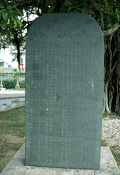Saion was another reformer who continued much the same work and ideology of Haneji Choshu and helped bring about important political reform by advancing various polices. Saion was from Kumemura, a place where many of the Chinese stayed when in the Ryukyus. He studied Confucianism and divination (Fusui) from a young age and went to China to be schooled in the practical sciences to aid in the reconstruction of the Ryukyu Kingdom. Saion's talent did not escape the court and he achieved the high rank of Sanshikan in 1728. His policies were similar to Haneji's in his belief of the importance of cooperative policies toward the Satsuma domain that ruled them. He attempted to secure forest resources, achieve financial reconstruction of the Ryukyu Kingdom, including revitalization of the agricultural villages, which were suffering from abject poverty.
Saion first established life improvement precepts called the Go-kyo-jo based on Confucian thought in order to secure greater control over the agricultural villages. And he preached that all people, including farmers and public officials should follow its moral precepts. Movement from the agricultural areas to the city was prohibited under agricultural policies. Farmers were urged to concentrate on improvements in agricultural production.
Saion himself journeyed throughout the island to promoted river improvements and irrigation. Reforestation and other forest conservation policies were one of the valued achievements of Saion. An increase in population at that time caused increased consumption of resources such as construction materials and firewood. Saion appraised the situation and established regulations for replanting and taught forest management methods.
In financial reconstruction of the government of Ryukyu Kingdom, he strengthened the Ryukyu monopoly system for the important trade goods turmeric and crude sugar, which were special products of from the Ryukyus. Furthermore, a system was created to purchase raw sugar at a low price outside of the tax. There was naturally much criticism in this kind of powerful political reform. A scholar, Heshikiya Chobin, who was subsequently executed as a rebel, started one incident of resistance to the new policies of the government of the Ryukyu Kingdom. While Saion carried out the administration of the kingdom, he also wrote many books utilizing his various academic experiences. These writings influenced the bureaucracies of the early modern age. Scholars such as Iha Fuyu and Majikina Anko in modern Okinawa conducted study of his works as well.

